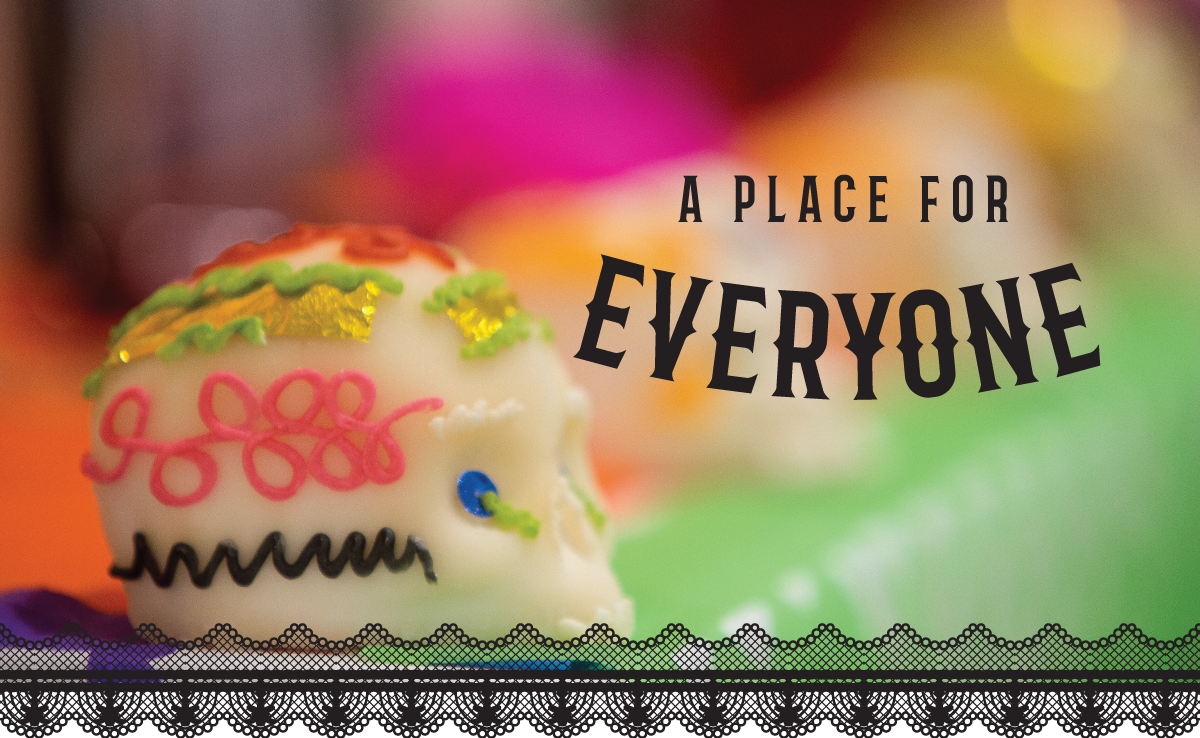A Place for Everyone
This is not the staid and stuffy scene you might expect in an art museum: Happy voices echo as children, parents and college students huddle around tables coloring, cutting and folding Dia de los Muertos crafts. A preschooler pages through a gallery catalog. A young family draws on the entryway sidewalk with chalk.
But then, Hope College’s Kruizenga Art Museum is not a staid and stuffy place where visitors are expected to shuffle about with whispers and contemplative gazes. “We want the museum to be a laboratory for learning but also a place for people to enjoy themselves,” explained Charles Mason, director and Margaret Feldmann Kruizenga Curator of the museum that opened just over a year ago.
“Enjoy” was the operative word on this late October Saturday, with students and the Holland community invited to a Dia de los Muertos (Day of the Dead) Community Day, complete with a traditional ofrenda, treats, festive craft projects and student-led tours—in Spanish—of the current exhibit of Mexican art.
Hope’s Latino Student Organization (LSO) organized the event. Its president, Maria Garcia, a junior from Chicago, Illinois, said celebrating the ofrenda at the Community Day was particularly meaningful. “It is a little piece of home. Born in Mexico, I remember decorating ofrendas, coloring skeletons to hang around the school or home, and especially the candy skulls,” she said.
With craft projects underway in one museum gallery, the other featured the large ofrenda, or altar, built to honor the dead. A group of 50 students gathered the night before to decorate it in honor of significant Latin cultural figures including Cesar Chavez, Juan Gabriel, Diego Rivera and Selena. The colorful, multi-level structure included sugar skulls, traditional foods and drinks, pottery and elaborate papelle picado—lace-like cut paper decorations.
“This is a dream. We’ve come a long way; it’s absolutely incredible,” Garcia said. Previous years’ ofrendas were not as elaborate or in such prominent locations, added Iliani Perez Rodriguez, vice president of the Latino Student Organization and a senior from Williamston, Michigan, who planned the event with Garcia.
In conjunction with its fall exhibit “After the Rupture: New Directions in Mexican Art 1960s-1980s,” museum staff reached out to involve the Latino Student Organization. The Dia de los Muertos celebration came about. “For the past several years, LSO has tried to make this day better each year, so when Charles contacted me about this opportunity, I was overwhelmed with joy,” Garcia said. The museum already had included other students in staging the exhibit, such as Spanish majors who translated labels and design classes that offered layout ideas.
Student and community involvement is intentional at the Kruizenga. “The museum was created to function as an educational resource for the college, but also to be a point of intersection between the campus and the community,” Mason said. “By involving students in activities like the Day of the Dead Community Day, we hope to make the museum more comfortable and more fun for everyone, from the campus and community alike.”
The opportunity to connect with families in Holland—which is 23 percent Hispanic—was significant, said Ernesto Villarreal, assistant director of Hope’s Center for Diversity and Inclusion. “For some of these kids, it might be the first time they interact with a college setting. For some of these kids, it might be the first time they see a Latin American college student. We want to empower our students to serve as models for the next generation.”
Garcia and Rodriguez hoped the event would teach visitors more about the tradition that is a national holiday in Mexico and celebrated in various ways throughout Latin America.
It also presented a chance for students from different Latin nations—and non-Latin students—to learn about each other. “It’s really a beautiful thing when you see students from all over talk about it—this is the tradition we had, versus the tradition you had… Seeing them come together and make something like this, where everyone has their own little twist on it, is really a joy,” Villarreal said.
He praised the opportunity and support that museum staff gave the students. “It’s exciting to see this can be a space where we’re actively displaying the rich diversity that we have at Hope, and that students who historically may not have had a significant voice can now see a powerful part of their history and culture on display.”
It’s also significant that the “voice” could include laughter and chatter of children and parents and students, right alongside a significant art exhibit. “We realize that many people are not inherently attracted to art museums,” Mason said, “but we hope that by involving a broad range of people in our exhibitions and programs, we can create a network of human connections that makes the museum more approachable and enticing for people to visit.”
“The museum was created to function as an educational resource for the college, but also to be a point of intersection between the campus and the community. By involving students in activities like the Day of the Dead Community Day, we hope to make the museum more comfortable and more fun for everyone, from the campus and community alike.”









